_We may earn revenue from the products available on this page and participate in affiliate programs. Learn more ›
_
When it comes to antique fishing lures and other tackle, I’m more of an accumulator than a collector. If I see something cool for short money at a tag sale, then I’ll latch on to it. I don’t collect systematically, nor do I spend big bucks on antique fishing tackle as some do.
This old, wooden Huskie Pikie plug by Creek Chub is a good example of a nice tag-sale get from a few years back, complete with the original box.
Rob Pavey, a noted classic-lure collector from Georgia, very graciously collected a series of old fishing lure photos below, that are great fun to look at along with being very informative.
Meanwhile, I’m sure we’ll get the inevitable question that always goes something like this: “I found an old wooden Do-Hickey lure in Grandpa’s tacklebox that I’m sure must be worth at least $123,458.31 to some collector. How do I sell it and get all that money?”
The answer, of course, usually goes like this: “Don’t bet the farm on it, kid. Maybe 5 bucks for it if you’re really lucky. Those things are a dime a dozen, and yours is all scratched up with rusty hooks.”
But then again, you never know…
The Best-Looking Wooden Fishing Lures
1. Best Imitation of a Catfish
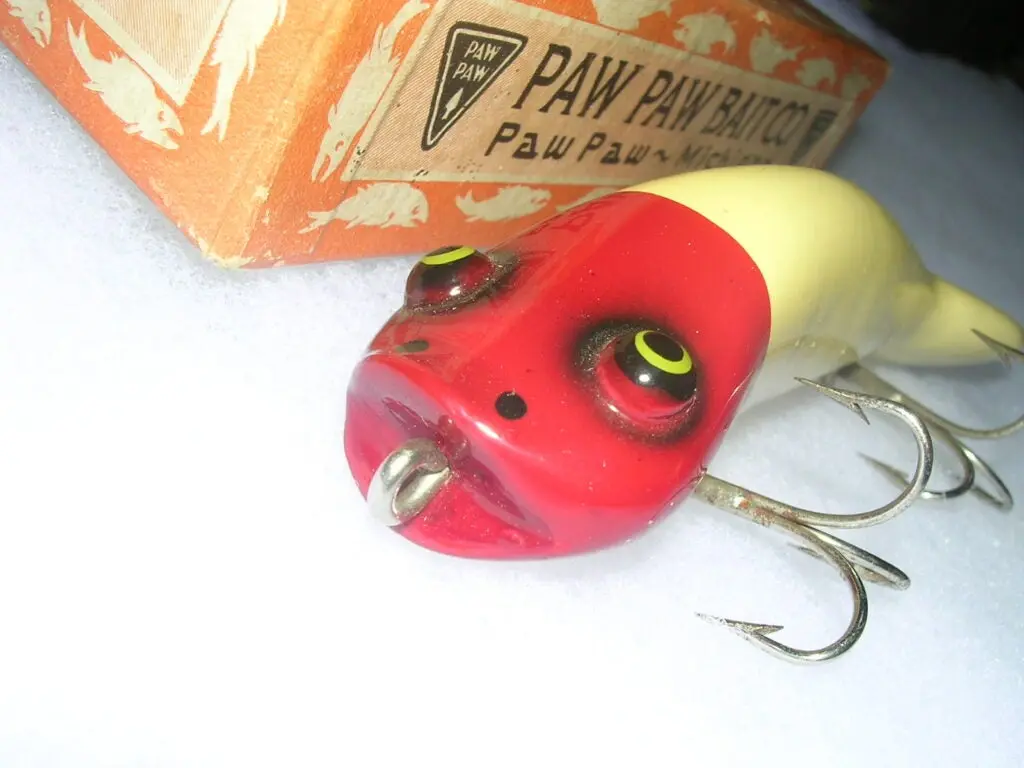
The Bullhead, made by Paw Paw Bait Co. of Paw Paw, Michigan, dates to the 1930s. Field & Stream Online Editors
The Bullhead, made by Paw Paw Bait Co. of Paw Paw, Michigan, dates to the 1930s. The bait was short-lived—probably due to the difficulty in shaping its elaborate body. The Bullhead baits even had carved lips and hand-painted whiskers.
2. Most Artistic Antique Fishing Lure
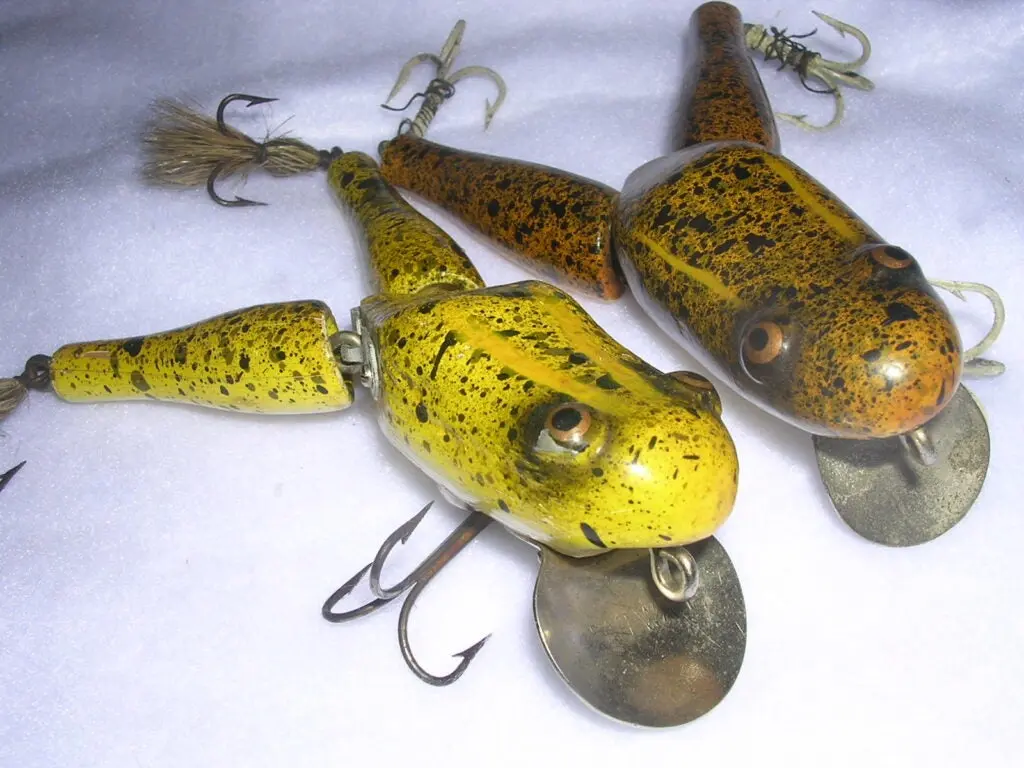
The wooden “Wotta Frog” was made by Paw Paw Bait Co. of Paw Paw, Mich. Field & Stream Online Editors
The wooden “Wotta Frog” was made by Paw Paw Bait Co. of Paw Paw, Mich., from the late 1930s all the way into the early 1960s. Its “wotta frog splatter” paint finish is one of the most unique in the world of antique fishing tackle. The lure’s articulated legs and lifelike bulging eyes make this one of the more collectible fishing lures on the list.
3. The Antique Fishing Lure Most Likely to be Seen in an Art Gallery
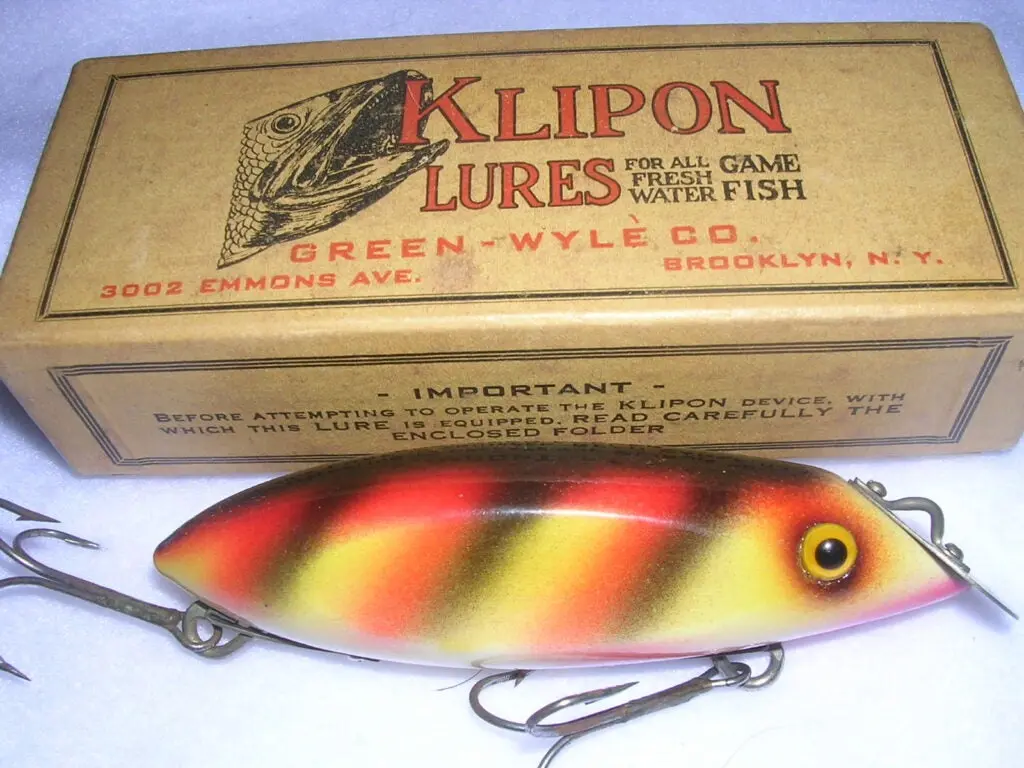
The wooden baits have glass eyes and came in a variety of unusual and unique shapes. Field & Stream Online Editors
Get out your best bottle of cabernet, dim the lights and push that Mozart CD. Now you’re ready to check out the workmanship of the Klipon lure, made in the 1930s by Green-Wyle Co., of Brooklyn, N.Y. The wooden fishing lures have glass eyes and came in a variety of unusual and unique shapes. This one gets my vote for the most beautiful rendition of a natural perch finish.
4. Most Beautiful Unpainted Wooden Fishing Lure
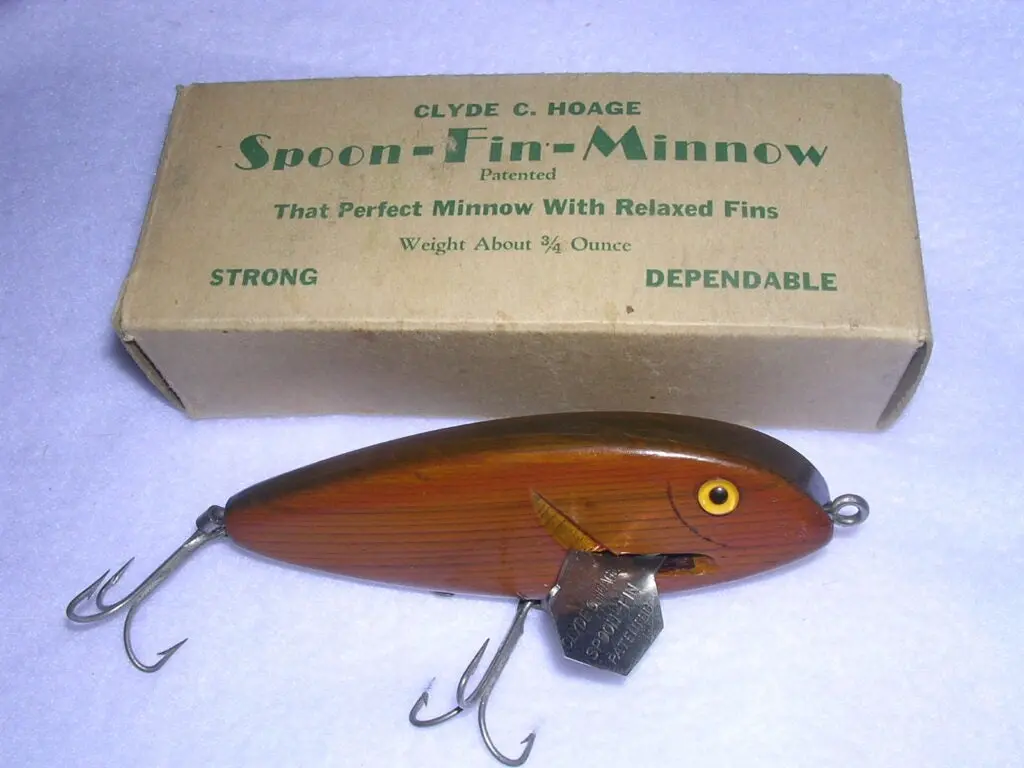
The Hoage Spoon-Fin was usually finished in natural wood. They are rare. Field & Stream Online Editors
The Clyde Hoage Spoon-Fin Minnow is a 1930s Minnesota lure with a finely machined set of animated metal fins. The Hoage Spoon-Fin was usually finished in natural wood. They are rare and highly collectible fishing lures. Spoon-Fin boxes are difficult to find, too. The Hoage Spoon Fin’s makers called it “The Perfect Minnow.”
5. Best Use of Child Labor
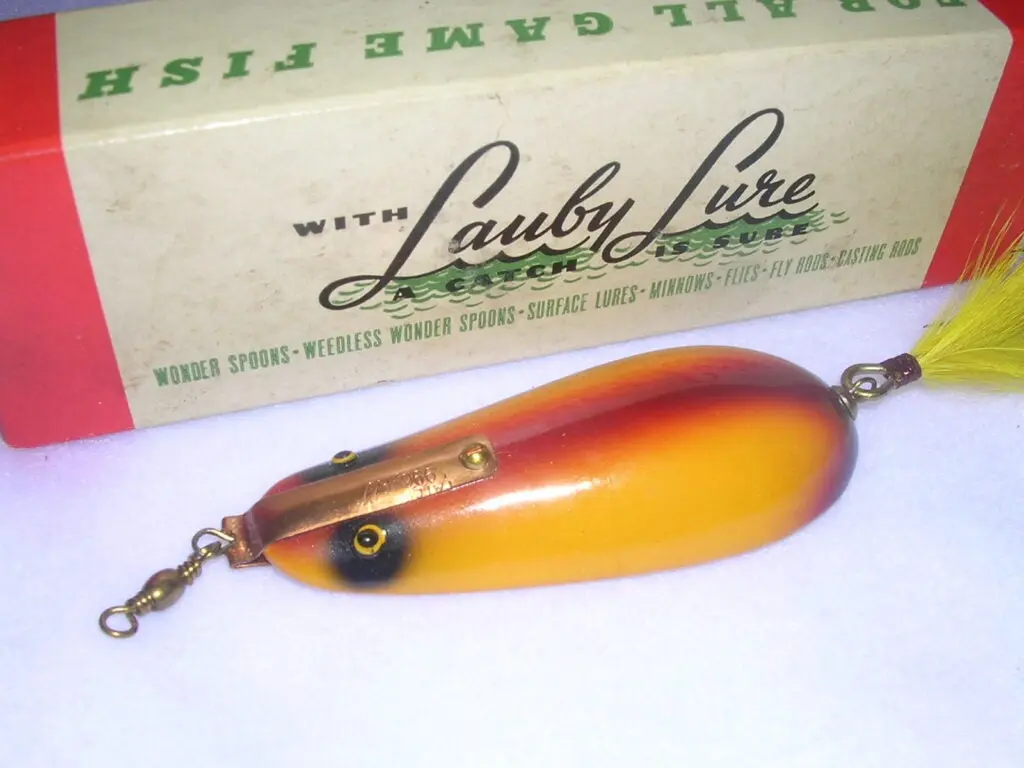
Anton Lauby patented his wooden “Wonder Spoon” lures around 1935. Field & Stream Online Editors
Anton Lauby patented his wooden “Wonder Spoon” lures around 1935. His company, based in Marshfield, Wisc., was sold in 1938. Lauby’s young daughter, Tillie, helped paint the unusual lures, and sometimes painted her fingernails in similar patterns. Lauby also obtained patents for several of the tools he engineered for building his baits.
Read Next: The 20 Best Ice Fishing Lures Ever
The Most Complicated Antique Fishing Lures
6. Most Likely to Annoy Greenpeace
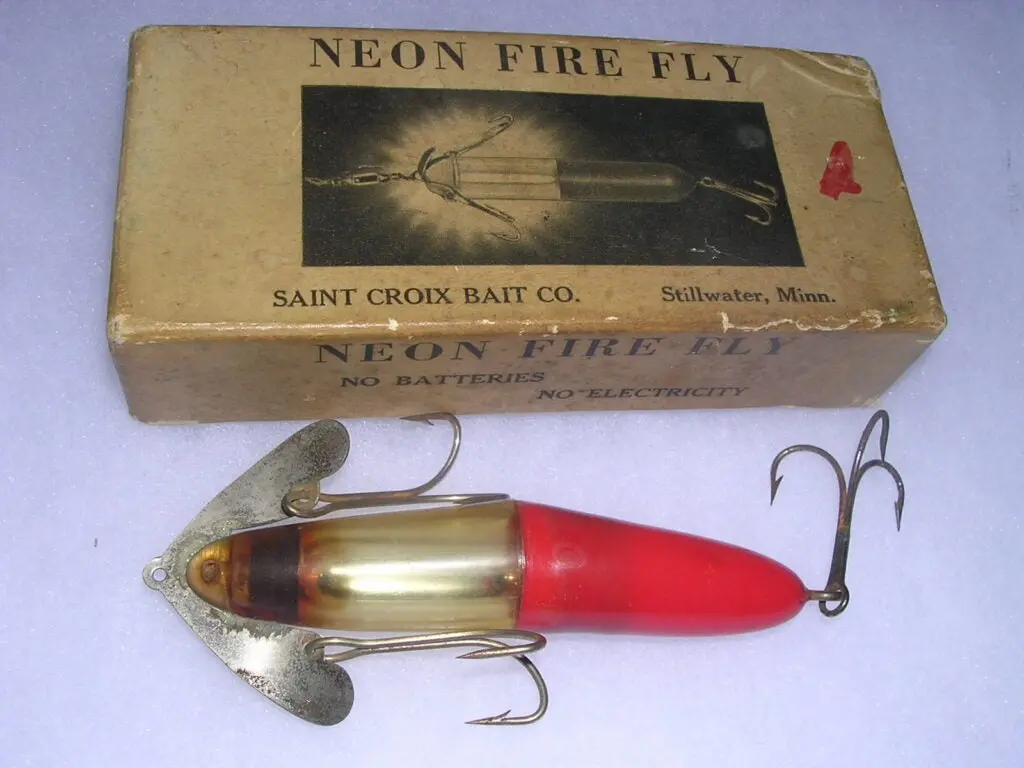
The Neon Fire Fly had a clear nose filled with 1.5 ounces of liquid mercury. Field & Stream Online Editors
The Neon Fire Fly, made in the 1930s by St. Croix Bait Co., Stillwater, Minnesota, had a clear nose filled with 1.5 ounces of liquid mercury to make the lure “glow.” Not many of these vintage fishing lures survived, and we hope, for the environment’s sake, that not too many were made!
7. Best Mechanical Antique Fishing Lure
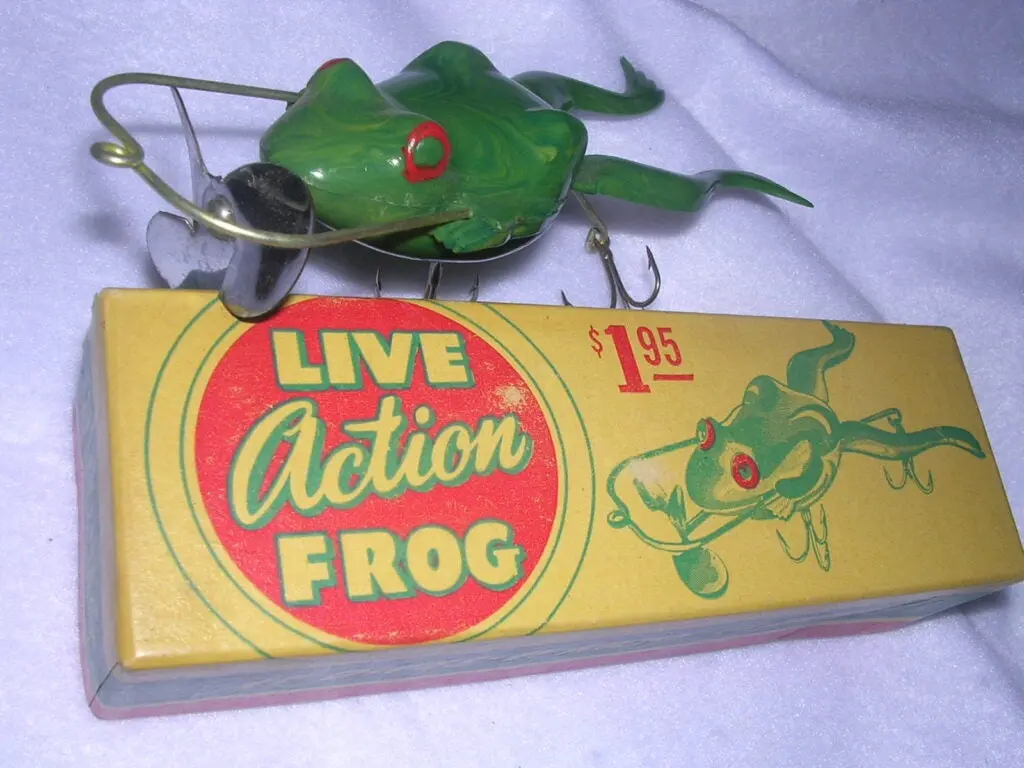
As the lure is retrieved, the prop turns a driveshaft that makes the legs kick open and shut. Field & Stream Online Editors
The prop-driven Live-Action Frog, made by Action Frog Corp. of Long Beach, Calif., in the late 1940s, is a favorite among collectors of mechanical lures. This frog features a four-bladed stainless steel prop protected by a device at the mouth that looks like a dental retainer from our childhood. As the lure is retrieved, the prop turns a driveshaft that makes the legs kick open and shut. Its tall, handsome picture box is an added plus.
8. Most Likely to Hurt You Before You Catch a Fish

The makers included William F. Harlow, a well-known outdoorsman and pattern maker for the Worley Stove Manufacturing Co. Field & Stream Online Editors
The E-Z Way Bass Bait, made around 1915 by Harlow & Steinbaugh of Newark, Ohio, is unquestionably one of the most dangerous lures ever manufactured. The hooks, when set, make the lure weedless, but when the trigger mechanism releases the barbs, it springs open several inches. The flyer inside its purple-maroon box starts out with some important advice: “Look Out!”
The makers included William F. Harlow, a well-known outdoorsman and pattern maker for the Worley Stove Manufacturing Co. Harlow also manufactured and sold duck decoys and duck calls. Little is known about his partner, Johnny Steinbaugh, although his descendants operated a family sporting goods store for many years in downtown Newark.
9. Most Laborious Antique Fishing Lure to Construct
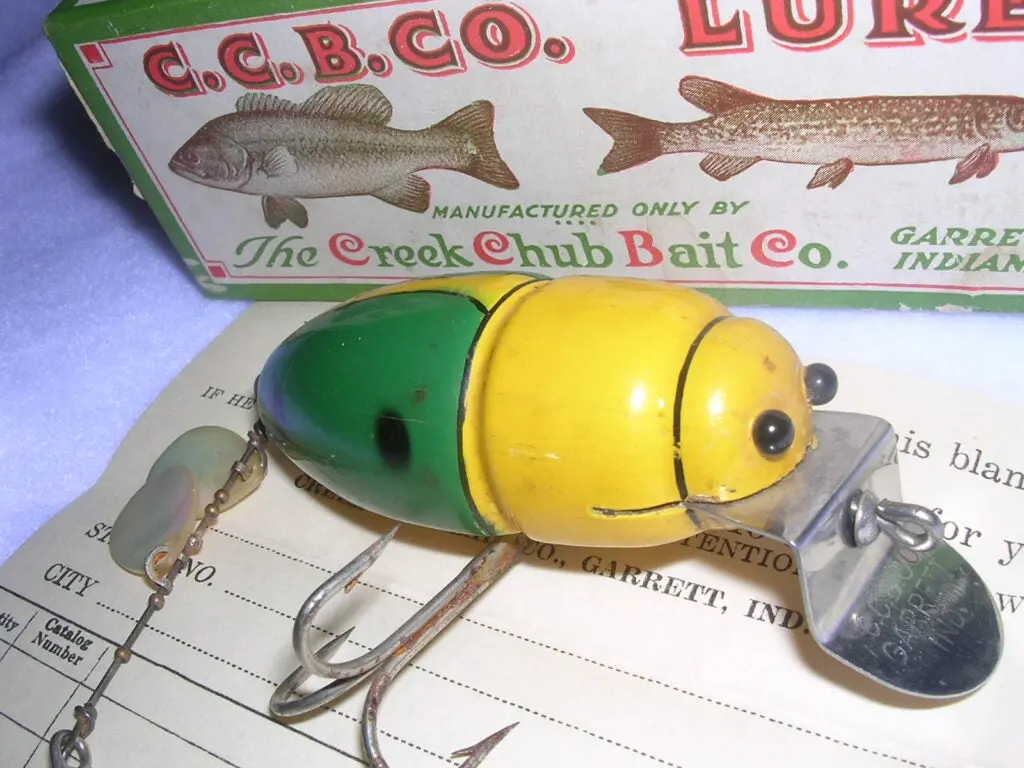
The diving lip fits neatly into the notched mouth and the tail section includes two pearl spinner blades. Field & Stream Online Editors
There are many baits that could fall into this category, but the Beetle lures made by Creek Chub Bait Co. of Garrett, Indiana, get my vote. The wooden fishing lure bodies had to be whittled and turned, and then the belly flattened. Eyes were set by hand and multiple layers of primer, paint and varnish were followed by the hand-applied black outlines separating the “wings” from other sections. The diving lip fits neatly into the notched mouth and the tail section includes two pearl spinner blades. This vintage fishing lure was made in at least seven colors and two sizes.
10. Best Imitation of an Entire Food Chain
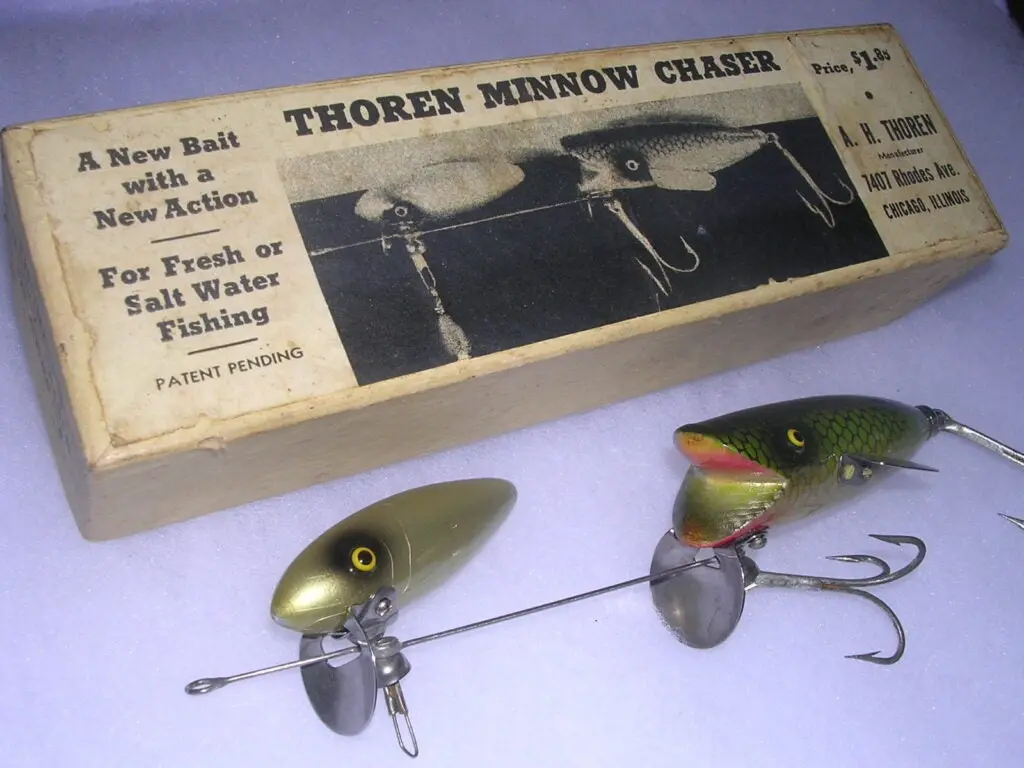
The Thoren Minnow Chaser was designed to mimic a fish chasing a fish. Field & Stream Online Editors
The Thoren Minnow Chaser was an elaborate bait made by A.H. Thoren of Chicago around 1940. It was designed to mimic a fish chasing a fish, and features some of the most elaborate mechanical hardware ever used in a lure. It must have made quite a sight moving through the water! The lures are wooden and very well made. The metal parts are machined steel.
The Most Popular Antique Fishing Lures
11. Most Likely to be Found in Every Tackle Box from the ’30s to the ’60s
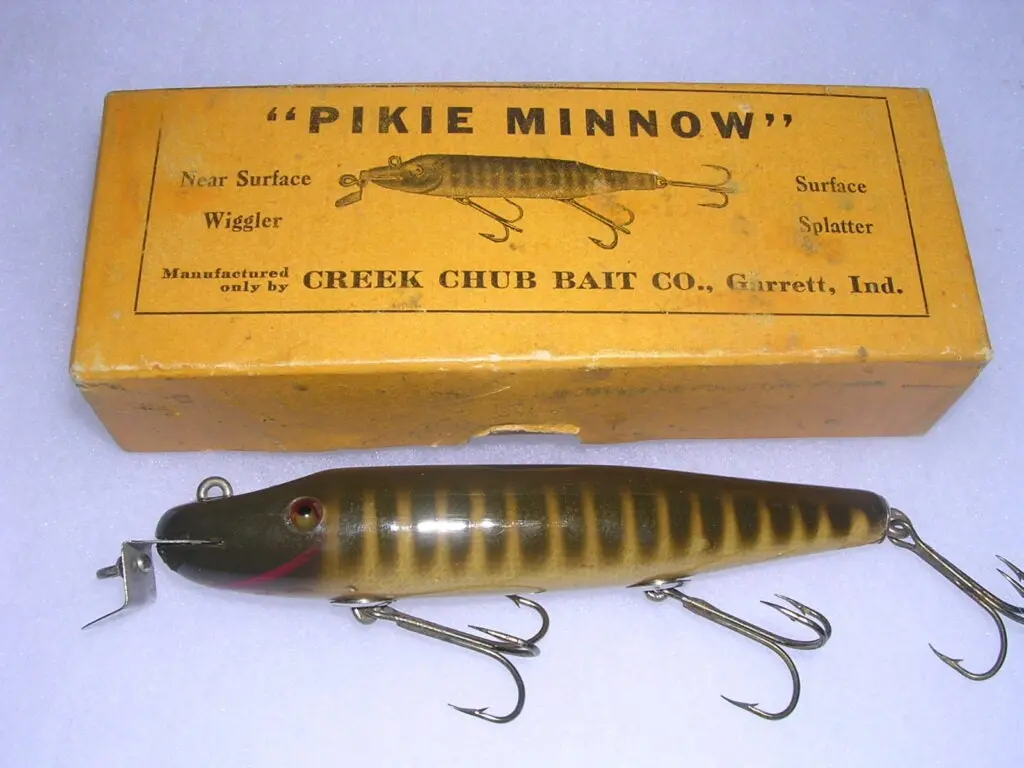
Creek Chub Bait Company’s Pikie Minnow originated around 1919 and evolved to include numerous sizes. Field & Stream Online Editors
Creek Chub Bait Company’s Pikie Minnow originated around 1919 and evolved to include numerous sizes, from a tiny flyrod version to a huge musky and tarpon bait. Although the colors varied, the basic body shape remained much the same. These lures later were known at the “Famous Pikie Minnow” because they were, indeed, famous—and they still are.
12. Happiest Looking Antique Fishing Lure
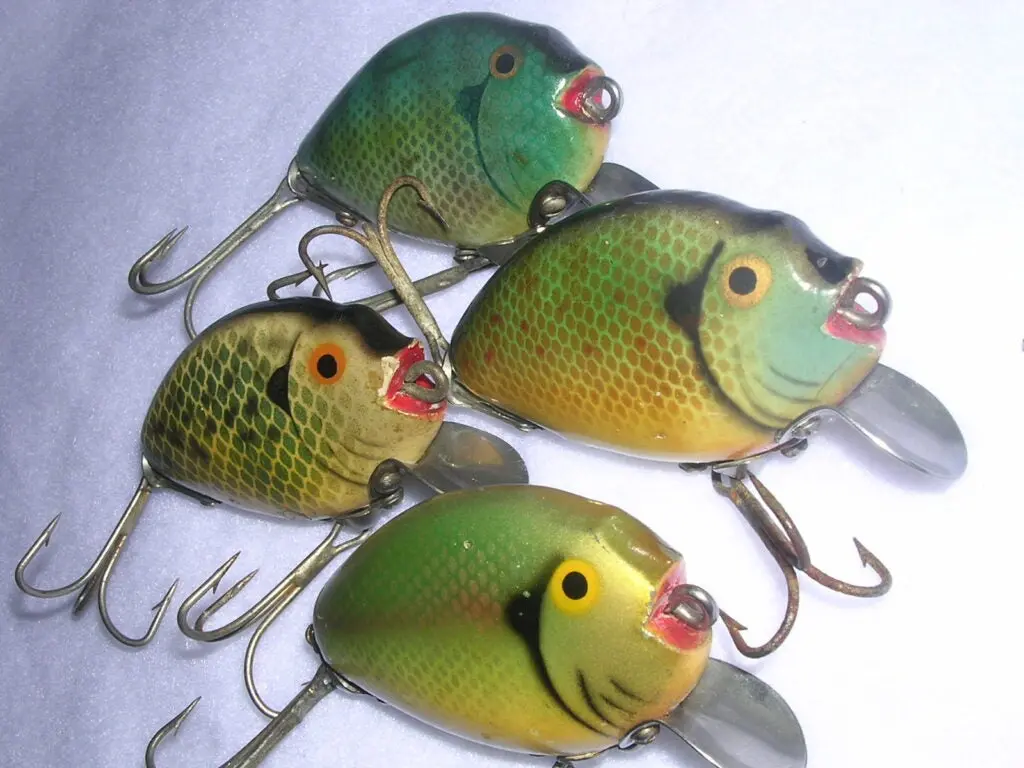
The “Punkinseed” was one of many famous baits from the Heddon company in Dowagiac, Michigan. Field & Stream Online Editors
The “Punkinseed” was one of many famous baits from the Heddon company in Dowagiac, Michigan. The tall, shaped “seeds” made their debut in the late 1930s with the larger wooden 740 series, soon accompanied by a smaller 730 series. It evolved over the years to include a tiny flyrod size (the Punkie Spook) as well as a host of bass-sized plastic versions. Their smiling mouths, cute shapes, and lifelike renditions of bluegill, crappie, rock bass, shad, and other species makes them a perennial favorite.
13. Most Likely to Stand the Test of Time

This one also gets our vote for one of the best all-time fish catchers. Field & Stream Online Editors
The famous Bass Oreno lures made by Indiana’s South Bend Bait Co. emerged around 1916 and are still on the market today. There are collections of Bass Oreno baits with more than 400 sizes, colors, and eye detail styles—without a single duplicate. This antique fishing lure also gets my vote for one of the best all-time fish catchers.
14. Most Memorable Misprint
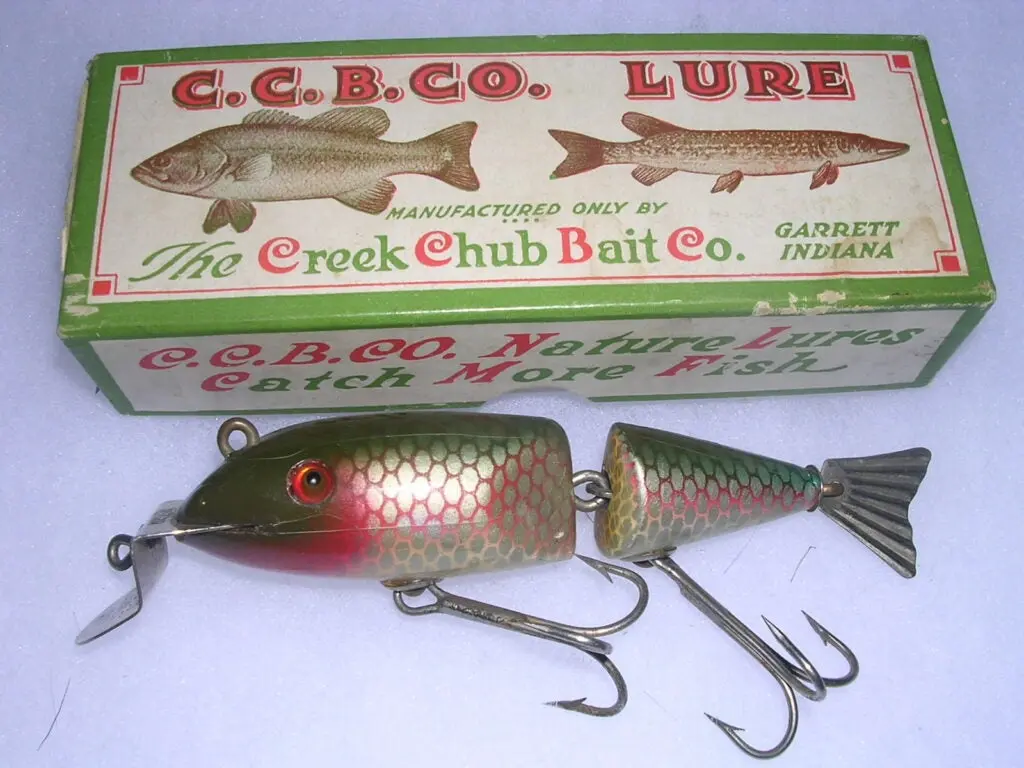
The Creek Chub Wigglefish was marketed as the bait used to land the 22-pound, 4-ounce world record largemouth bass. Field & Stream Online Editors
For many decades, the Creek Chub Wigglefish was marketed as the bait that was used by George W. Perry to land the 22-pound, 4-ounce world record largemouth bass
caught in Georgia in 1932. As it turns out, the famous fish was actually landed on a different Creek Chub lure—the Fintail Shiner. The revelation was made in an audio recording of George Perry himself—interviewed on Oct. 12, 1973, by an outdoor writer named Terry Drace, working at that time for Bass Anglers Sportsman Society. The long-lost audiotape surfaced just three years ago—and set the record straight.
15. Best Proof That Size Doesn’t Matter
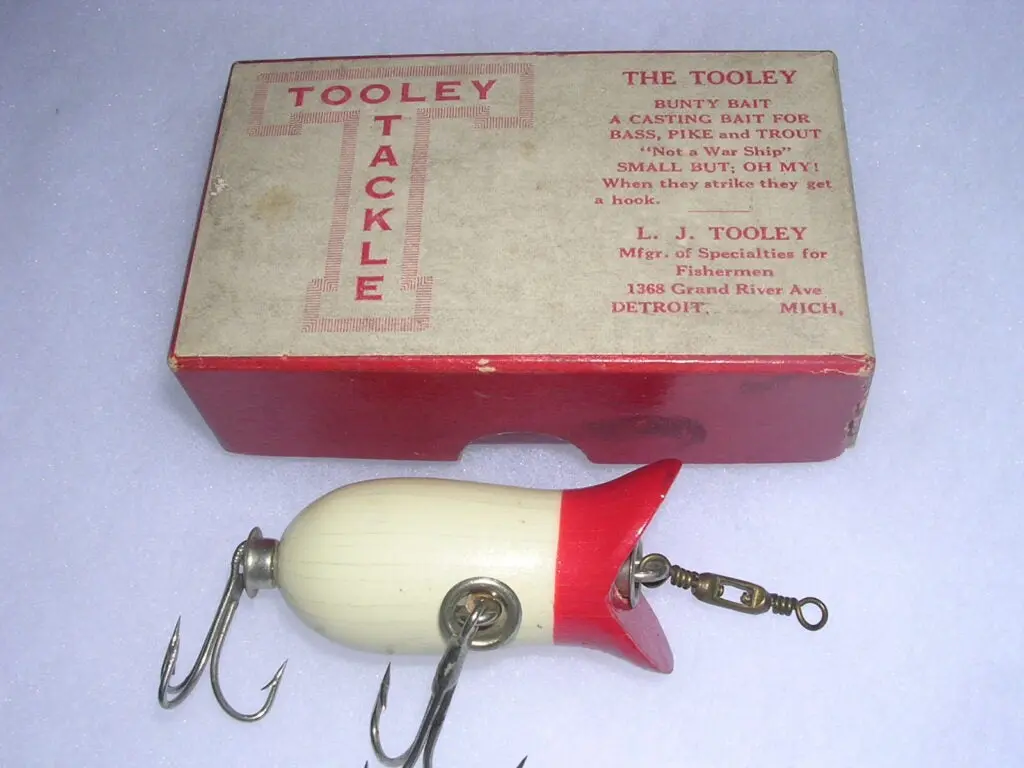
L.J. Tooley of Chicago was a world champion baitcaster who marketed lures in the early teens. Field & Stream Online Editors
L.J. Tooley of Chicago was a world champion baitcaster
who marketed lures in the early teens. His wooden Bunty lures sometimes had a hanging belly weight. The box says this relatively small lure is “not a warship” like bigger plugs of the era—an obvious snub at the huge wooden fishing lures of the time that often had five treble hooks.
Read Next: The 50 Greatest Lures of All Time
The Strangest Antique Fishing Lures
16. Best Adaptive Reuse of Skunk Parts
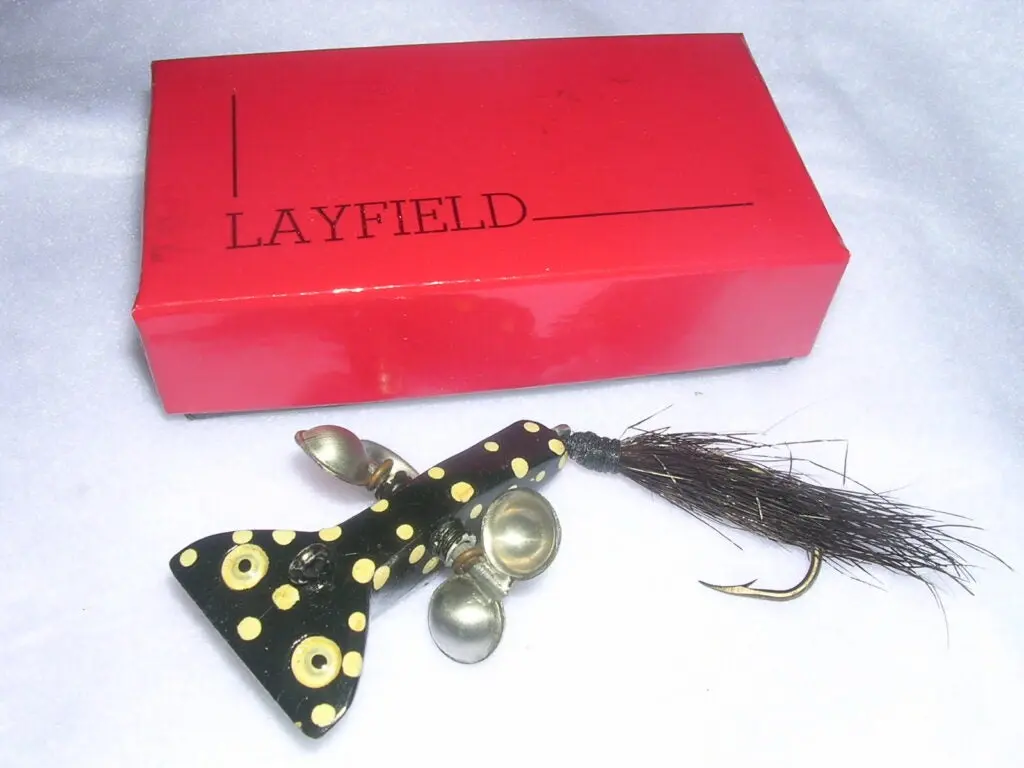
“Cotton’s Topwater” was a unique paddle-wheel bait designed to skim atop weeds in shallow lakes. Field & Stream Online Editors
“Cotton’s Topwater” was made by Cotton Layfield of Kerens, Texas, and was a unique paddle-wheel bait designed to skim atop weeds in shallow lakes. Cotton Layfield made the baits with his brother, Jess. The hackle on this topwater lure
was made from skunk hair—which the makers deemed the best for flotation and durability. This particular antique fishing lure, by the way, was a gift from the Layfields to the late Bob Brister, a veteran journalist for Outdoor Life magazine.
17. Weirdest Use of Raw Materials
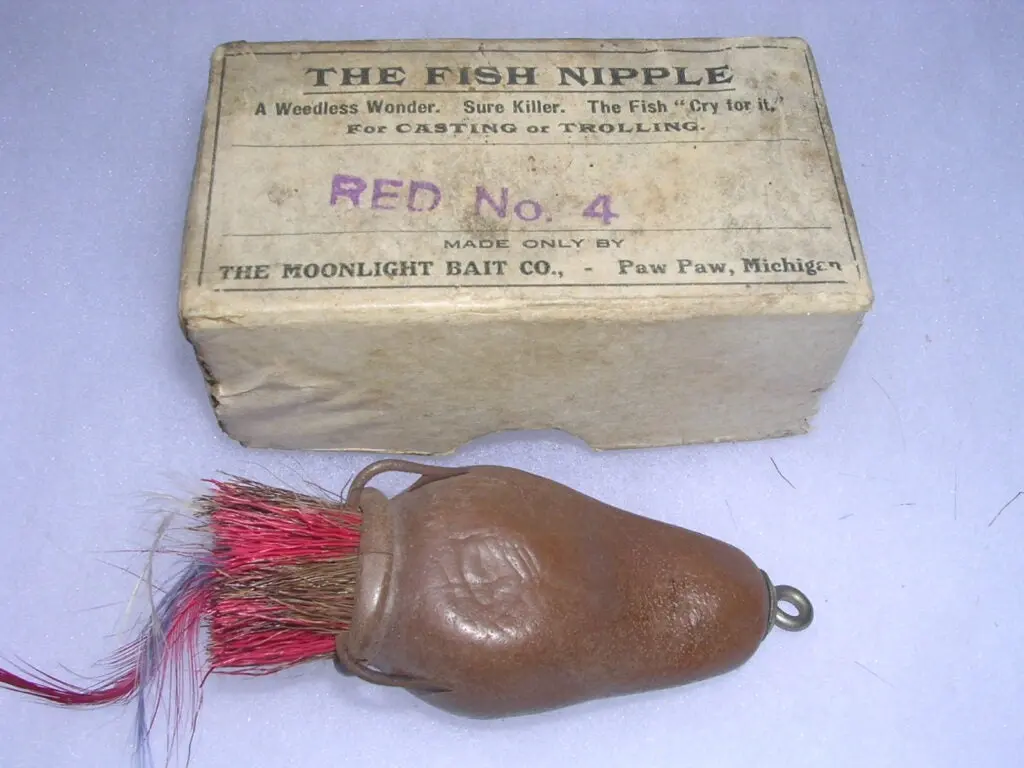
The Fish Nipple is perhaps one of the least elaborate baits from the storied lure company. Field & Stream Online Editors
The Fish Nipple, made around 1911 by Moonlight Bait Co., Paw Paw, Michigan, was just what its name made it out to be: a rubber nipple filled with lead, feathers and horse hair. It is perhaps one of the least elaborate vintage fishing lures from a company that made what are now some of the most collectible fishing lures ever.
18. Most Likely to Leave a Bigger Wake than the Fish it Catches
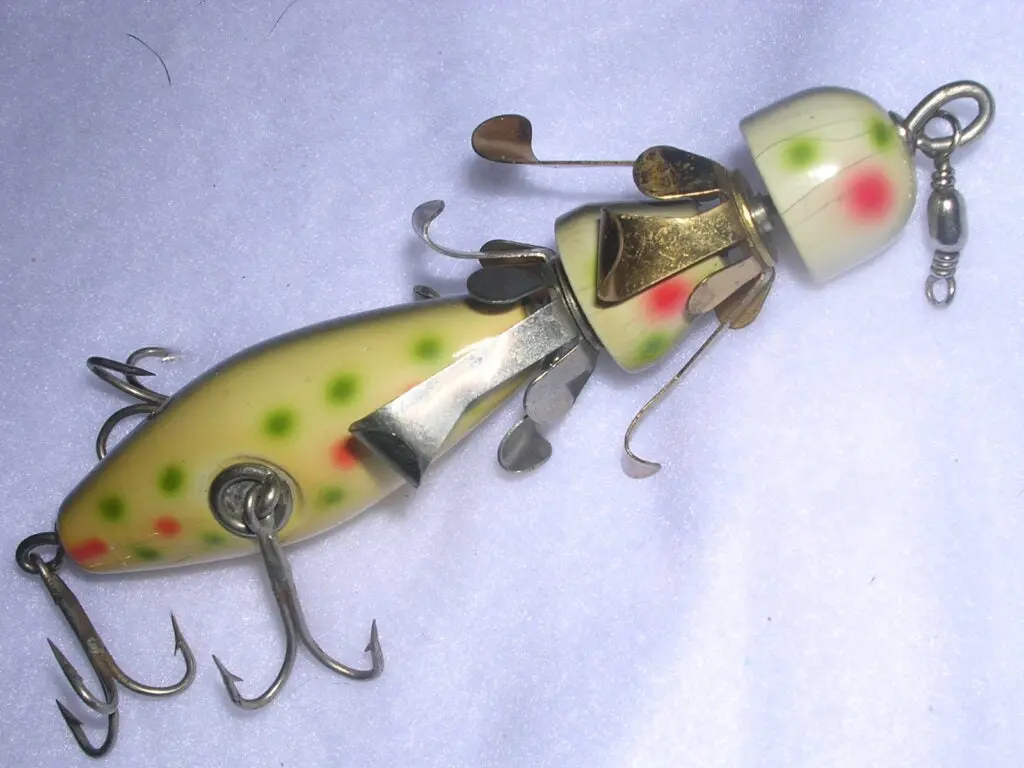
This classic lure – dating to around 1914 – was made by Union Springs Specialty Co. of Cayuga Lake, N.Y. Field & Stream Online Editors
Armed with a pair of propellers that have eight blades apiece, the Miller’s Original Wood Minnow (aka Miller’s Reversible) left a wake like a battleship. This antique fishing lure—dating to around 1914—was made by Union Springs Specialty Co. of Cayuga Lake, N.Y.
19. Most Likely to Require a Pollution Discharge Permit
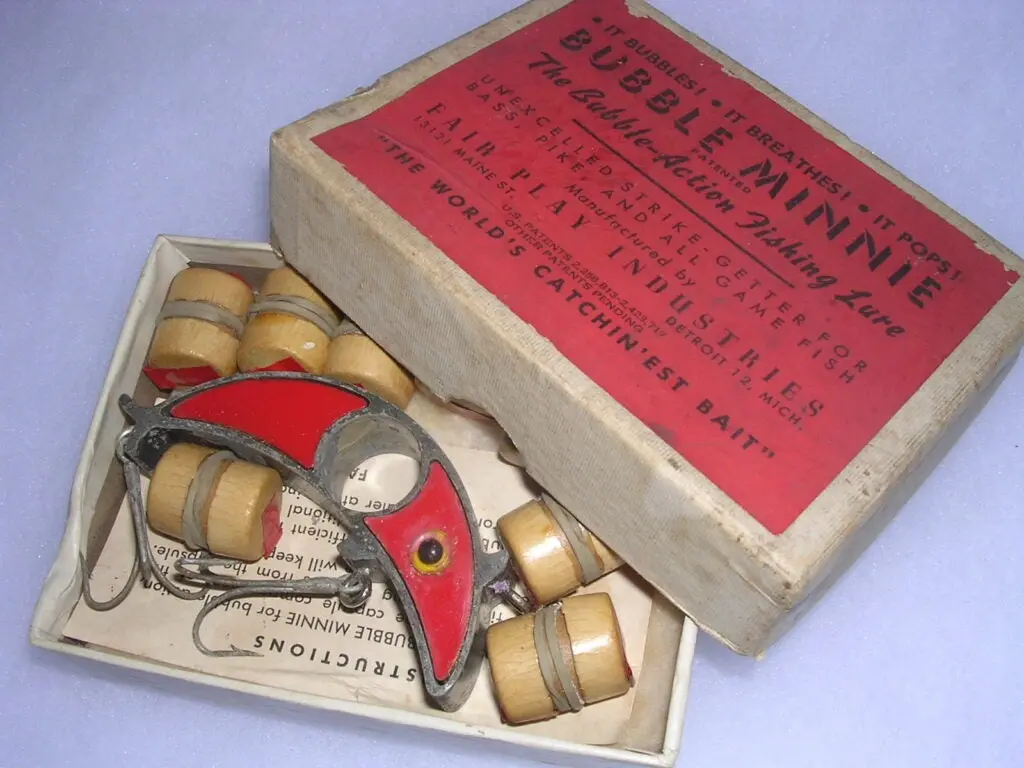
This unused Bubble Minnie was owned by noted Florida outdoor writer Ed McLaurin. Field & Stream Online Editors
The Bubble Minnie, made in the 1940s by Fair Play Industries of Detroit, features a blued aluminum frame with wooden “barrels” that fit inside the cavity. The barrels were filled with an unknown cocktail of foaming, fizzing chemicals and emitted a noisy trail of bubbles. This unused Bubble Minnie was owned by noted Florida outdoor writer Ed McLaurin, who accumulated many unusual lures sent to him by manufacturers seeking publicity.
20. Most Likely to be Mistaken for Your Pet’s Chew Toy
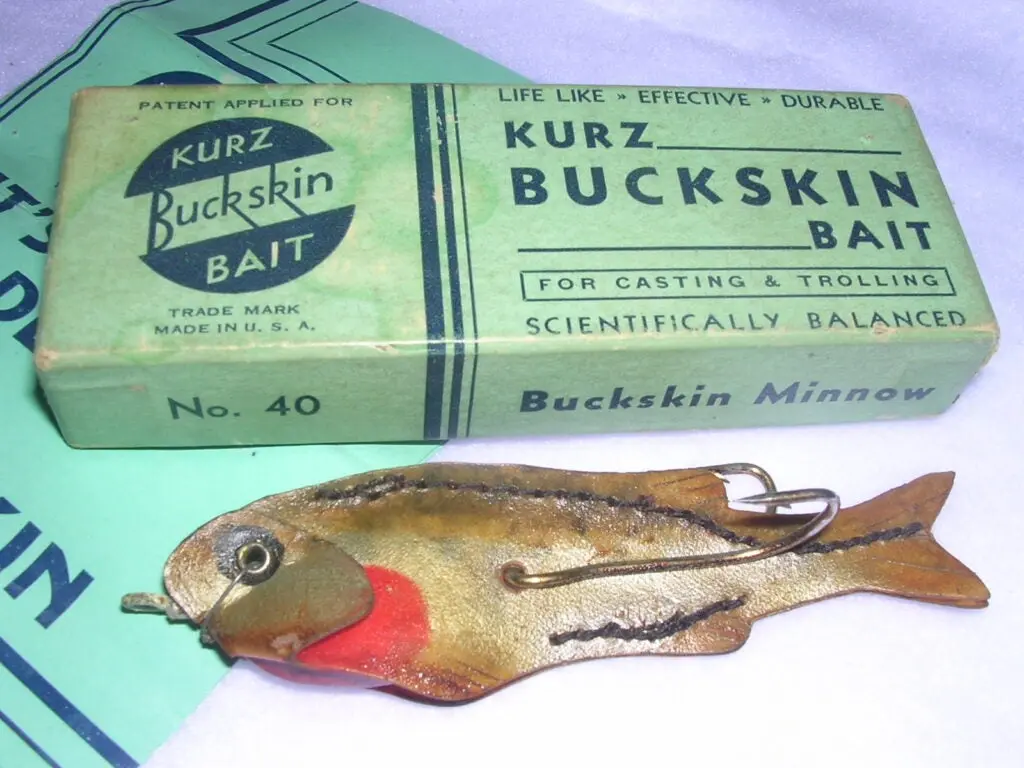
The Kurz Buck Skin bait is a hand-painted lure made from genuine rawhide. Field & Stream Online Editors
The Kurz Buck Skin bait is a hand-painted lure made from genuine rawhide, according to the literature accompanying this circa 1936 lure from Kurz Brothers Company of Chicago, which was located—perhaps not coincidentally—in the city’s famous stockyards district. The attractive lure features hand-painted gills, a riveted eye and an oblong external belly weight. After catching a few fish, however, it would very likely resemble a dog’s chew toy.
Antique Fishing Lures with the Best Advertising
21. Most Outlandish Marketing Claim for an Antique Fishing Lure
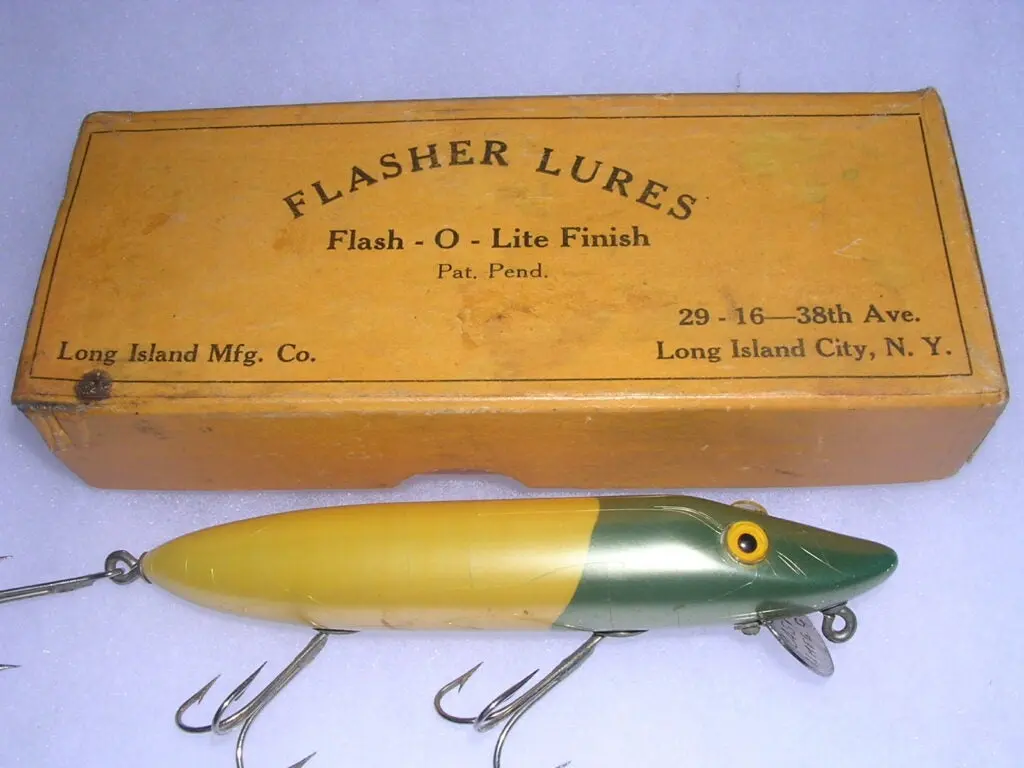
Long Island Manufacturing Co., New York claimed its proprietary, patented finish was made from actual fish scales. Field & Stream Online Editors
The Long Island Flasher, made in the 1930s by Long Island Manufacturing Co., New York, claimed its proprietary, patented finish was made from actual fish scales that helped give the lure its lustrous shine. The diving lip is stamped with the company name.
22. Best Marketed Antique Fishing Lure
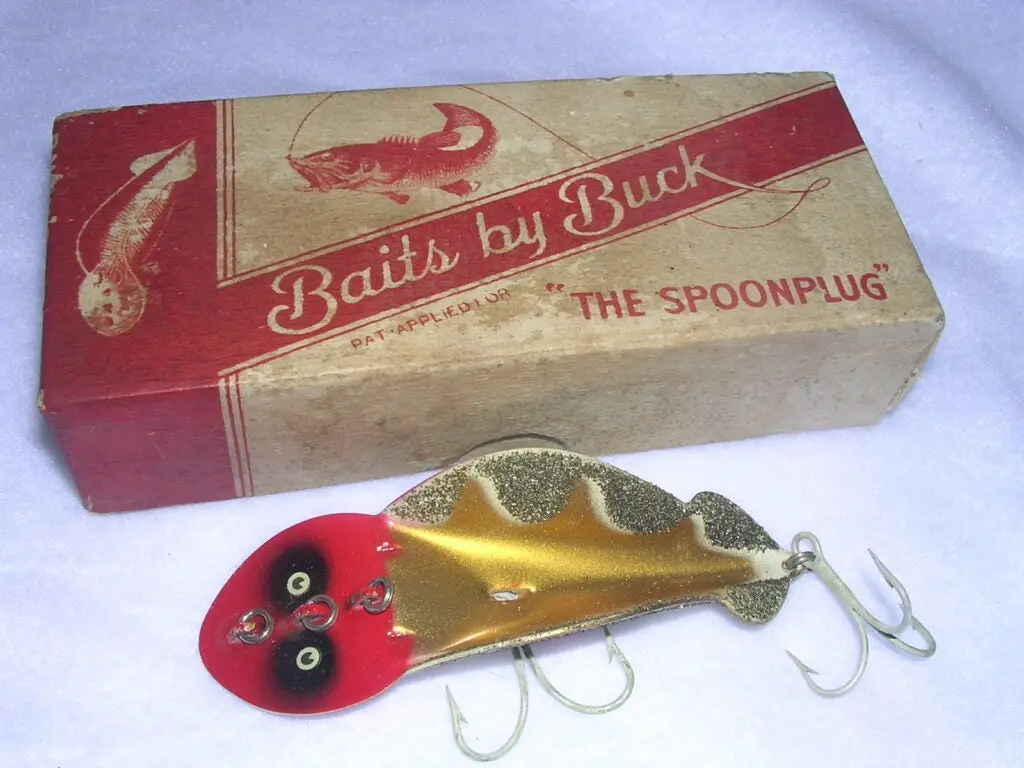
The Spoonplug was made by Buck’s Baits, founded around 1945 by Elwood “Buck” Perry of Hickory, N.C. Field & Stream Online Editors
The Spoonplug was made by Buck’s Baits, founded around 1945 by Elwood “Buck” Perry of Hickory, N.C. He was a marketing genius who traveled the country offering Spoonplugging seminars and selling his books on how to use the Spoonplug. The metal, painted lures came in an unending number of sizes and colors and are usually found in a plastic window box. This two-piece box is early and rare—making this a very collectible fishing lure. Perry died in 2005 at the age of 90 and his baits remain at work catching bass
to this day.
23. Best Use of Cartoon Characters
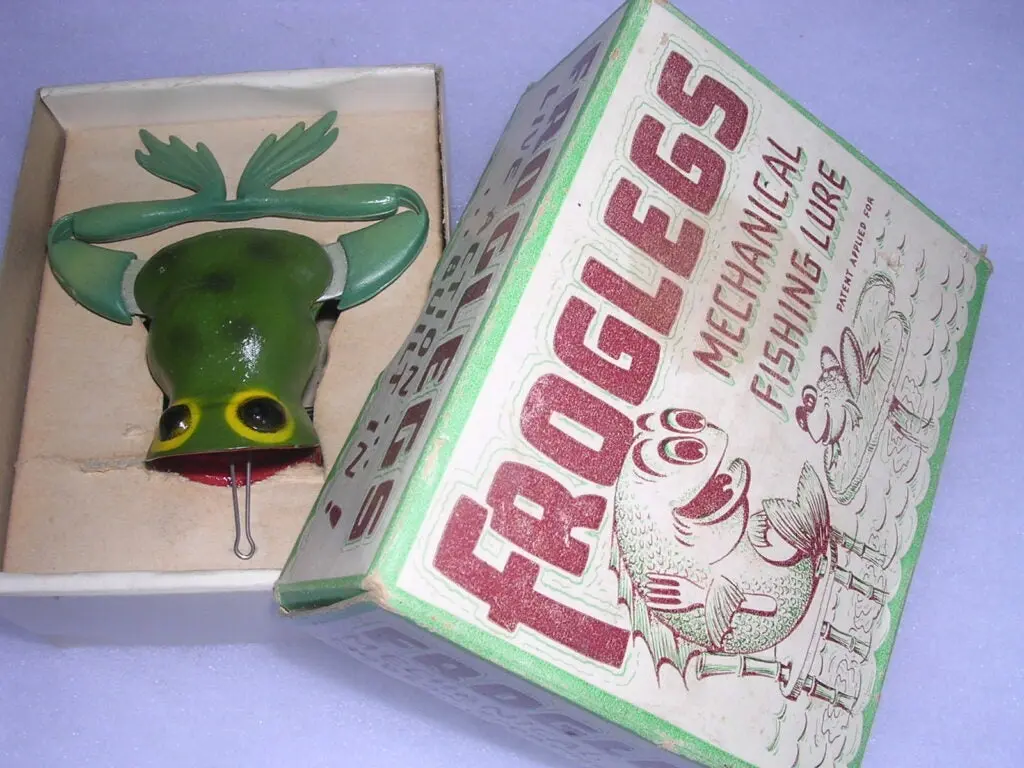
This “Froglegs Mechanical Fishing Lure” is one antique lure that actually caught fish. Field & Stream Online Editors
With a box that looks inspired by a Disney show, the very happy “Froglegs Mechanical Fishing Lure” was made in the 1950s by Modern Sporting Goods Co., Austin, Texas. It is among many mechanical frogs—and one that actually caught fish.
24. Most Attractive Antique Fishing Lure (Because the Box Says So)

The Charmer Minnow, dating to the 1911 era, was made in Springfield, Mo. Field & Stream Online Editors
The Charmer Minnow, dating to the 1911 era, was made in Springfield, Mo., and is among the best of the classic “barberpole” baits of the era. Its box proclaims that is “the most attractive fish lure any angler ever cast.”
25. Most Beautiful Product Flyer on an Antique Fishing Lure

The color papers have wonderful graphics unrivaled by product pamphlets of any other company. Field & Stream Online Editors
Patented in 1909 and sold for the first year or two in a wonderful black pasteboard box, the Howe’s Vacuum Bass Bait made in Manchester, Indiana, is an early classic. The lure featured “swiveling hooks” and all were made of wood. The color papers have wonderful graphics unrivaled by product pamphlets of any other company.
26. Best Use of Graphics on a Box Top
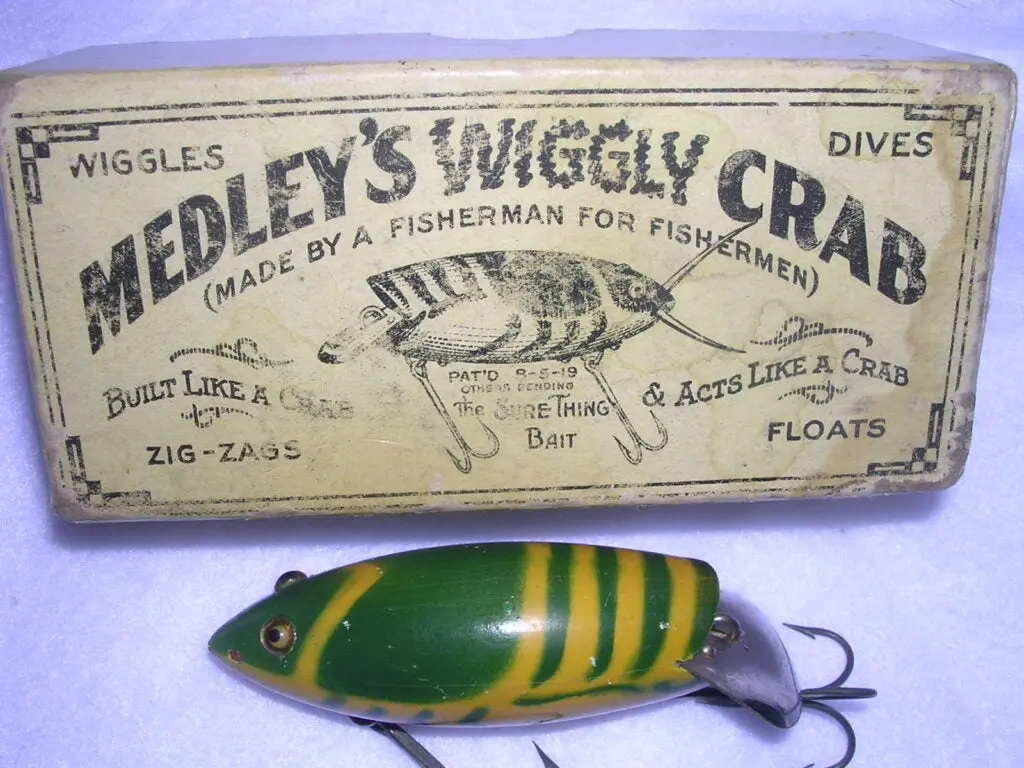
Harry L. Medley of Los Angeles patented the Medley’s Wiggly Crab in 1919. Field & Stream Online Editors
Harry L. Medley of Los Angeles patented the Medley’s Wiggly Crab in 1919. This is the rare first box, which contains a lure stamped “Patd.,” (later lures carry the 1919 date). Note the wonderful graphics in this exquisite picture box, with the word “Wiggly” being really wiggly to the eyes. Although the Medley lures are gorgeous, their boxes no doubt made them a hit with anglers.
Most Innovative Antique Fishing Lures
27. Most Creative De-Snagging Invention

These hollow lures have an internal spring designed to un-snag the lure. Field & Stream Online Editors
The South claims few true classic lures, but the spring-loaded Vann-Clay Retrievable Minnow made by Thelma H. Clay of Thomasville, Ga., in the late 1920s can hold its own against any early maker. These hollow lures have an internal spring that enables the head to pull away from the body when snagged, then snap back, hopefully unsnagging the lure.
28. Most Likely to Revolutionize Bass Fishing

William Shakespeare of Kalamazoo, Michigan, offered his “Revolution” baits around 1900. Field & Stream Online Editors
William Shakespeare of Kalamazoo, Michigan, offered his “Revolution” baits around 1900. They were made of aluminum and floated on the surface in an era in which most lures were underwater baits.
Read Next: The 25 Best Topwater Lures Ever Created
29. Most Effective Revolving Bait
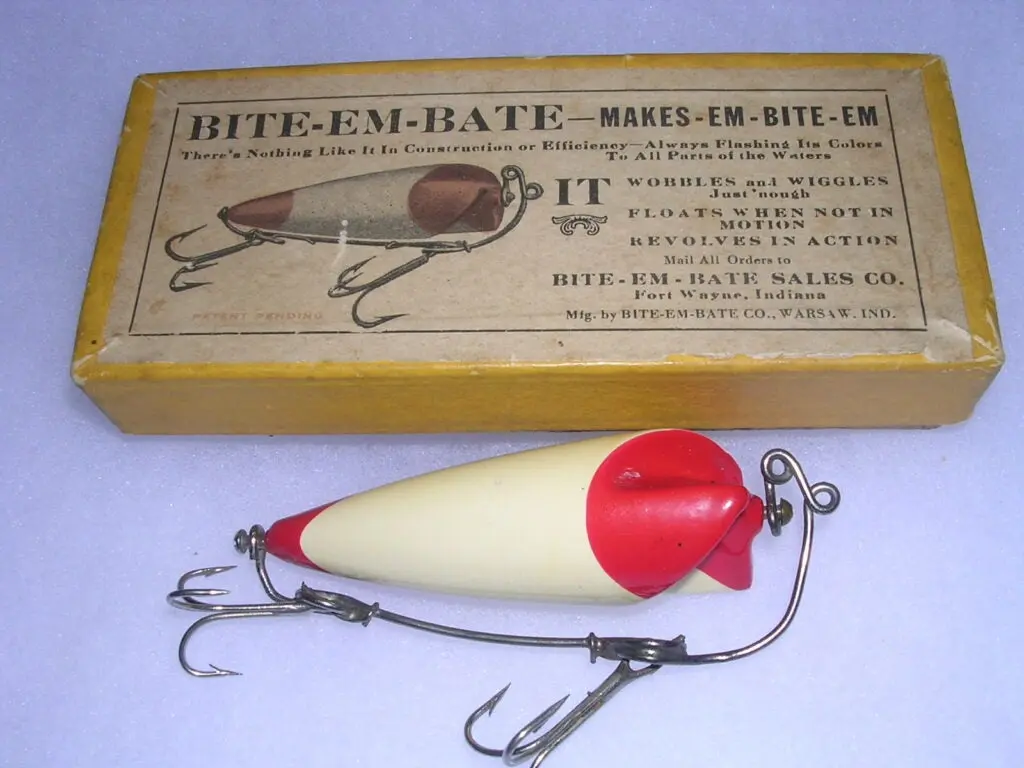
Bite-Em Bate lures are among the most colorful and sophisticated antique fishing lures. Field & Stream Online Editors
Bite-Em Bate lures are among the most colorful and sophisticated antique fishing lures. Manufactured only briefly, from around 1917 into the early or mid-1920s, the Bite-Em Baits (or “Bates” as some boxes proclaimed) included this wooden fishing lure that rotated on an axis with its unique hook armature.
30. Most Patriotic Paint Job
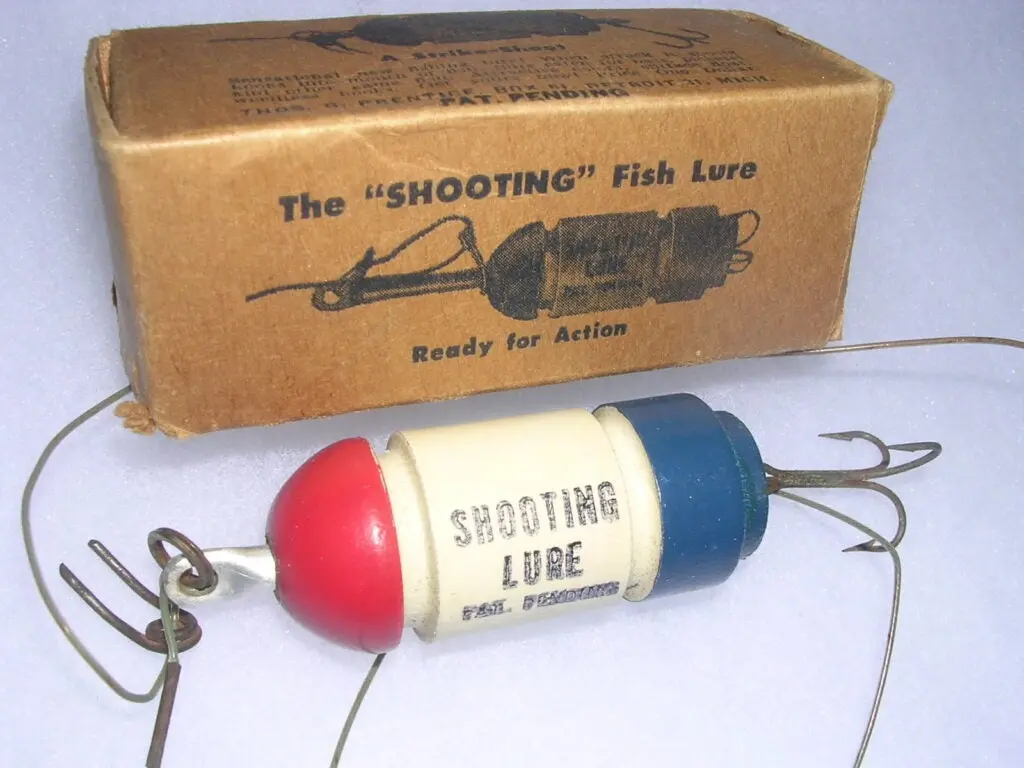
The Shooting Lure was painted a patriotic red, white and blue! Field & Stream Online Editors
The mechanical, spring-loaded Shooting Lure was made in the mid 1940s by machinist Thomas G. Prentice. This is the patent model with a metal shaft with slots into which a pin was inserted to hold it in the cocked position. When a fish struck, the pin was dislodged, and the lure “fired,” shooting the hook into the fish’s mouth. The Shooting Lure was painted a patriotic red, white and blue!

